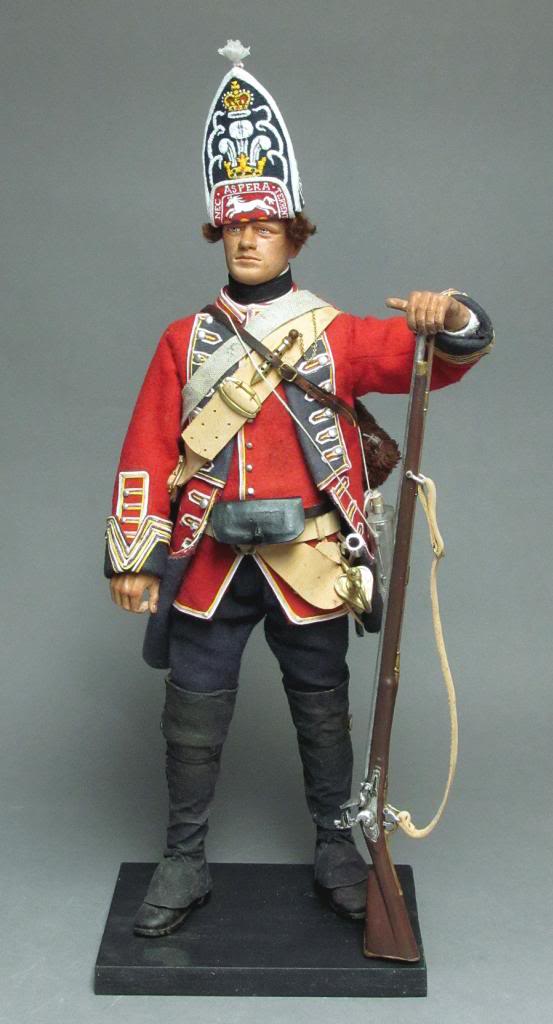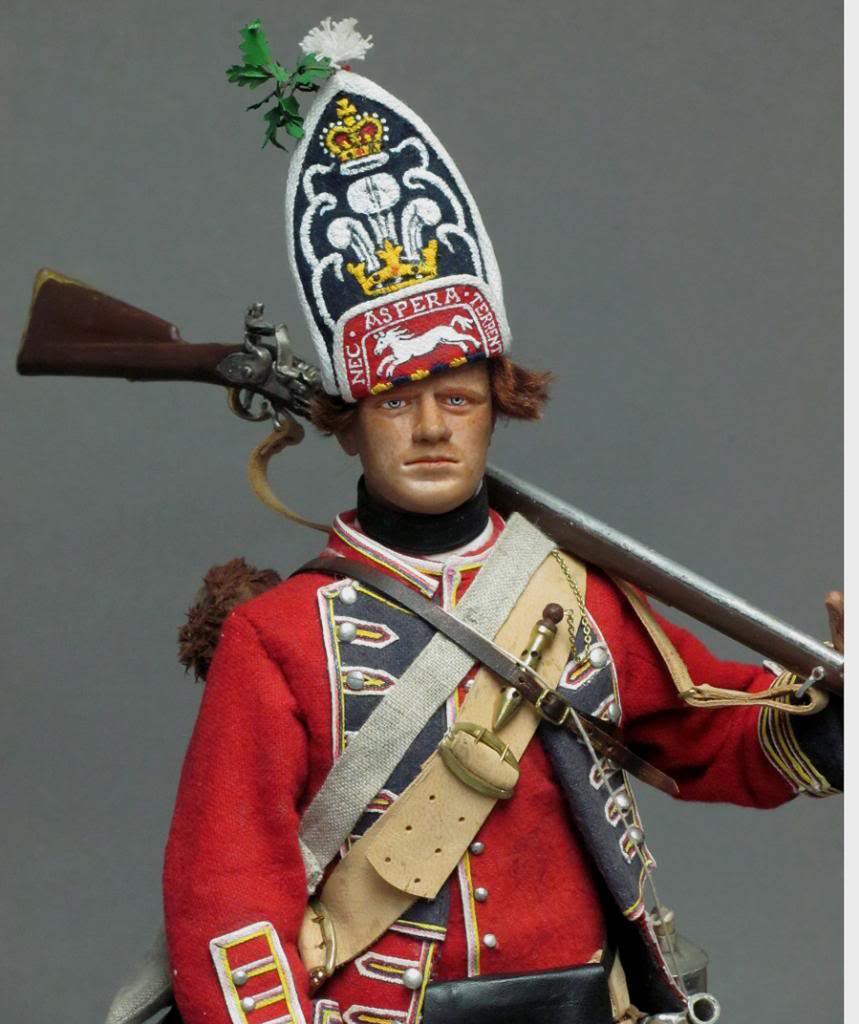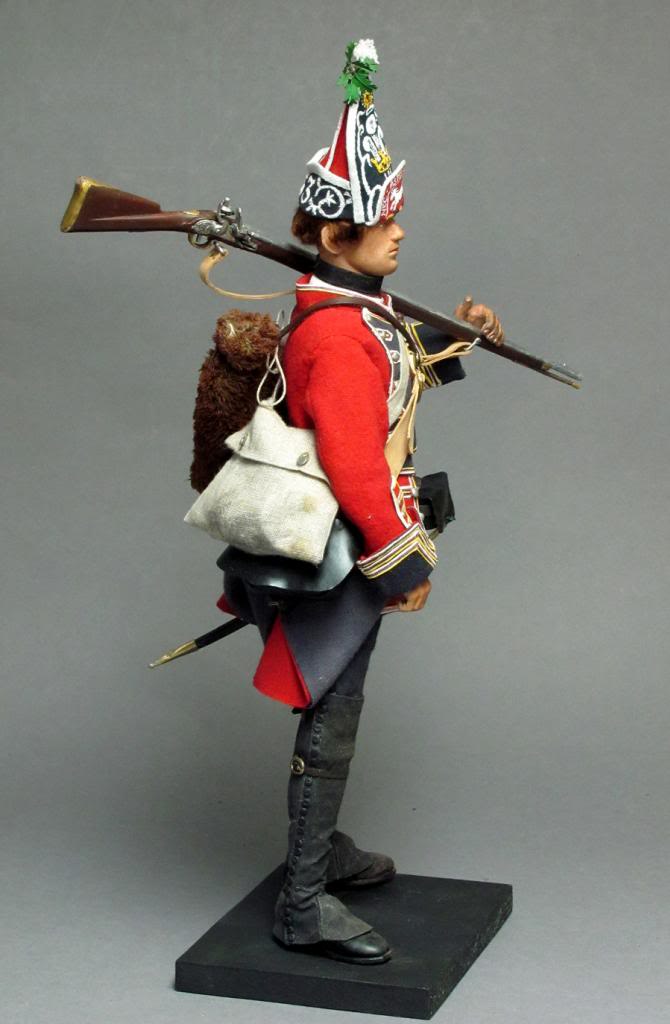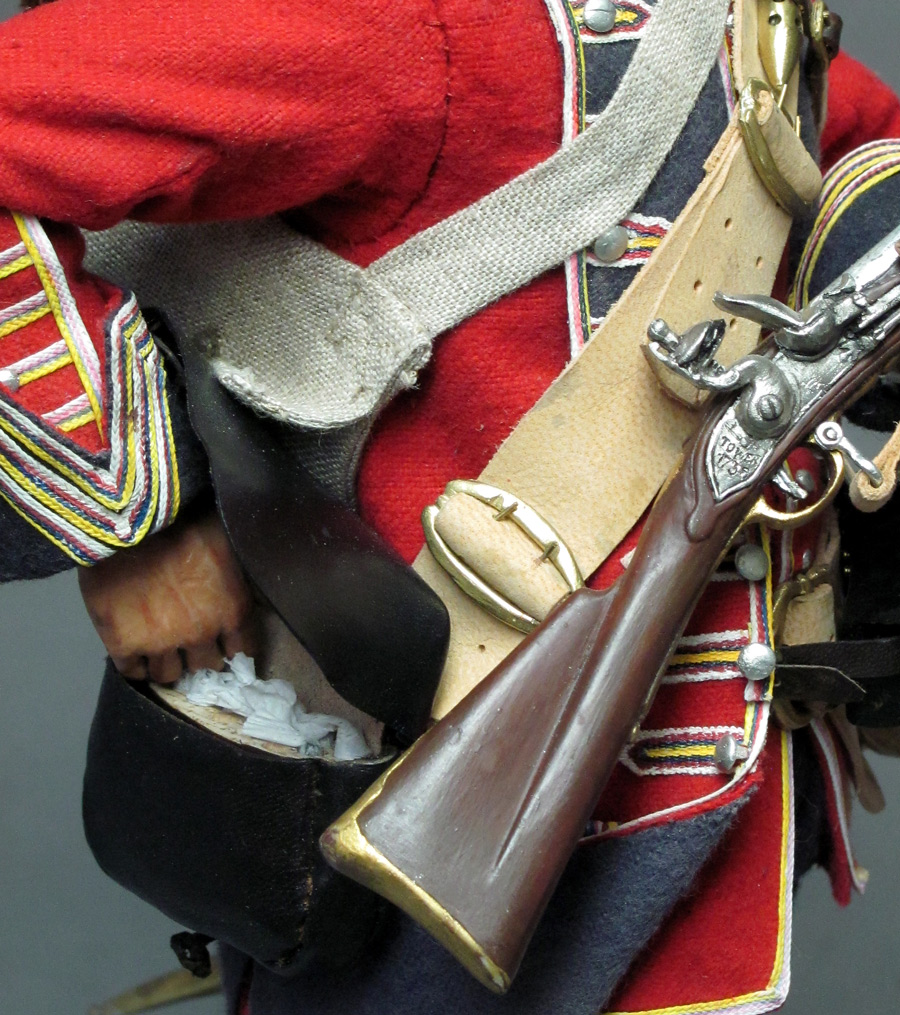Un Grenadier brittanique de la bataille de Dettingen, 1743.
J'ai fait ce modèle figure comme un défi, en raison de la complexité de l'uniforme. Ce n'était pas une bataille très importante, mais le soldat est typique de la période, quand uniformes dans la plupart des pays européens sont très ornementales.
Il est un grenadier de la célèbre 23e Régiment, intitulé Welch Fuzileers, qui est descendu des troupes spécialisées utilisées pour protéger l'artillerie. Ils étaient un régiment très célèbre et couronnée de succès, et leur descendant moderne est le Régiment Royal de Gallois.
Il porte le chapeau brodé typique de grenadiers, et est armé d'un long fusil, baïonnette et l'épée. Il transporte de l'équipement de la campagne d'un sac en peau de chèvre, un sac à dos de toile pour la nourriture, et une cantine d'étain pour la boisson.
Tout est fait sur mesure.
A GRENADIER OF 1743.Something from the most elaborate period of uniforms , just for the challenge…
The 23rd Royal Welch Fuzileers were a highly distinguished Foot regiment , with a record of Battle Honours second to none.
Their modern inheritor is The Royal Welsh Regiment.
They were at Dettingen in 1743 , and later at Minden in 1759 were one of the six Regiments who made the memorable advance against the French Cavalry.
They were later heavily engaged throughout the American Rebellion .

The Battle of Dettingen, June 10th 1743 is chiefly memorable as the last battle in which a British King was present in person .
It seem to have been a confused affair , with mediocre generalship by both sides, and not a great deal of glory for anyone.
You can read an excellent account here…
http://www.britishbattles.com/battle_of_dettingen.htmOur man is a Grenadier, who stood on the right of the Battalion, a select company of supposedly the biggest and bravest.
The actual use of grenades had lapsed, but the grenadiers still carried the emblems of that role, including a cap , a large pouch ( big enough for grenades as well as cartridges ) and a match case , which is the brass object on the front of his pouchbelt . Such Grenadiers were normal in all European armies and evolved as elite stormers in the siege warfare usual in the late 17th century. By the mid 18th , they were just the picked men of the battalion.

As a Fusilier regiment, all the soldiers wore the cap rather than the hat , but the Grenadiers used a slightly larger version .
( Fusiliers were originally an artillery guard armed with flintlocks ).
He has an oak sprig in the top, a field sign of Allied armies in Germany .

He also has an expense pouch worn on an extra narrow waistbelt, of leather moulded round a lightly curved wooden block .
Grenadiers also still carried swords at this date , though they were on the way out, and often discarded in campaigns soon after.
Many grenadiers carried basket-hilted swords , but the Morier painting shows the 23rd with a simple iron hilt, and a surviving 23rd sword from America is in brass, which is what I have chosen here.
The musket is the Long Land Pattern with the 46” barrel , which remained standard until the 1760s. The sling is worn loose .
As campaign equipment he carries haversack , tin canteen and a cowskin knapsack .Rations were mostly beef and bread, and each man was entitled to a gallon of beer per day, though obviously on campaign they had to make do with whatever was locally available.

The uniform is very elaborately laced , with worsted lace coloured in a regimental pattern of stripes . Stitching this together must have been a lot of work, and one pities the poor regimental tailors who had to fit and lace the new coats every year. The old coat was stripped and turned into a waistcoat .The cloth was very thick, and the whole coat weighed about twelve pounds .
As a sometime historical tailor myself , they have my sympathy. I reckon such a coat would have taken at least four days work to make .Mind you, the heavy cloth doesn’t fray , so edges tend to be just cut rather than turned in , which certainly makes less work than using modern materials.

Making the figure :~
This sort of complexity is only really possible with a lot of preparation and planning . The detail comes from two sources, the 1742 Cloathing book, and the Morier painting, which was done a little later at the end of the 1750s.

There is also this one, undated but earlier, which I believe shows a Fusilier of the Regiment with a slightly smaller cap with a different design. He has no match case, suggesting a centre company man.

They both wear white parade gaiters, black or brown being worn on campaign.
I make my uniforms from brushed cotton , dyed then painted, cut to original patterns where they exist , reconstructed where they don’t .The lace is painted 2mm lacet with coloured lines added with fine pens .
Buttons in pewter.
His cap is embroidered like the original : I know that sounds terrifying, but if you go about it carefully it can be quite fun.
I mark out the design on a much larger piece of cloth with chalk , then paint it , then embroider over the paint to get the 3D effect, then touch up with paint again before cutting it out. Some of it can be done on the machine, but it needs finishing by hand. But given how small it is, there’s not much area to cover.

The musket was made previously, and cast in resin with pewter fittings.
The equipment is goatskin, with brass buckles which I have had cast in Birmingham.
Calfskin over wooden blocks for the pouches.
His hair is acrylic , and plaited in the original style, the plait tucked up under the cap .

*********************************************************************************************************************************





